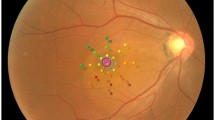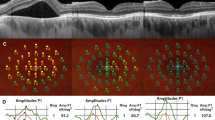Abstract
Objective: To study contrast sensitivity in patients who have recovered from central serous chorioretinopathy (CSC). Patients and methods: Thirty-one patients who had recovered from CSC were examined with the Vistech and Pelli-Robson contrast sensitivity charts. The time from the onsetof the active disease varied from 10 to 166 months (mean 60.4 ± 42.0, SD). The visual acuity was 1.0 (logMar 0) or better. Results: Contrast sensitivity of the affected eyes was significantly worse in the intermediate spatial frequenciesof 3 and 6 cycles per degree (cpd) in the Vistech test compared to the fellow eyes (p = 0.032, 0.013, respectively). Contrast sensitivity of the affected eyes wassignificantly worse in all 5 spatial frequencies of the Vistech test and in the Pelli-Robson test compared to age-matched normal eyes (p = 0.006, 0.000, 0.000, 0.018, 0.000, 0.000, respectively). Contrast sensitivity of the fellow eyes was significantly worse in the spatial frequencies of 3 and 18 cpd in the Vistech testand in the Pelli-Robson test compared to age-matched normal eyes (p = 0.020, 0.019, 0.000, respectively). Conclusions: Contrast sensitivity does not seem to recoverin all eyes after CSC even if the visual acuity has returned to normal. Therefore, contrast sensitivity testing is recommended for the patients complaining of visual impairment in spite of good visual acuity.
Abbreviations: cpd – cycles per degree;CSC – central serous chorioretinopathy;ICG – indocyanine green;RPE – retinal pigment epithelium.
Similar content being viewed by others
References
Gass JDM. Pathogenesis of disciform detachment of the neuroepithelium. Am J Ophthalmol 1967; 63: 587–615.
Piccolino FG. Central serous chorioretinopathy: Some considerations on the pathogenesis. Ophthalmologica 1981; 182: 204–210.
Marmor MF. New hypothesis on the pathogenesis and treatment of serous retinal detachment. Graefe's Arch Clin Exp Ophthalmol 1988; 226: 548–552.
Guyer PR, Yanuzzi LA, Slakter JS, Sorenson JA, Ho A, Orlock D. Mylene and carlo Digital indocyanine green videoangiography of central serous chorioretinopathy. Arch Ophthalmol 1994; 112:1057–1062.
Prünte C, Flammer J. Choroid capillary and venous congestion in central serous chorioretinopathy. Am J Ophthalmol 1996; 112, 26–34.
Shiraki K, Moriwaki M, Matsumoto M, Yanagihara N, Yasunari T, Miki T. Longterm follow-up of severe central serous chorioretinopathy using indocyanine green angiography. Int Ophthalmol 1998; 21: 245–253.
Gelber GS, Schatz H. Loss at vision due to central serous chorioretinopathy following psychological stress. Am J Psychiatry 1987; 144: 46–50.
Zamir E. Central serous chorioretinopathy associated with ACTH therapy. Graefe's Arch Clin Exp Ophthalmol 1997; 235: 335–344.
Wakakura M, Ishikawa S. Central serous chorioretinopathy complicating system corticosteroid treatment. Br J Ophthalmol 1984; 68: 329–331.
Chumbley LC, Frank RN. Central serous chorioretinopathy and pregnancy. Am J Ophthalmol 1974; 77:158–160.
Cruysberg JRM, Deutman AF. Visual disturbances during pregnancy caused by central serous chorioretinopathy. Br J Ophthalmol 1982; 66: 240–241.
Fastenberg DM, Ober RR. Central serous chorioretinopathy in pregnancy. Arch Ophthalmol 1983; 101: 1055–1058.
Klein ML, Buskirk MV, Friedman E, Gragondas E, Chandra S. Experience with nontreatment of central serous chorioretinopathy. Arch Ophthalmol 1974; 91: 247–250.
Sjöstrand J. Contrast sensitivity in macular disease using a small-field and large-field TV-system. Acta Ophthalmol (Copenh) 1979; 57: 832–846.
Kayazawa F, Yamamoto T, Itoi M. Contrast sensitivity measurement in retinal diseases by laser generated sinusoidal grating. Acta Ophthalmol (Copenh) 1982; 60: 511–524.
Mutlak JA, Dutton GN, Zeini M. Central function in patients with resolved central serous retinopathy. Acta Ophthalmol (Copenh) 1989; 67: 532–536.
Beuchat L, Simona F, Safran AB. Anomalies de la fonction retinienne (sens lumineux) apres chorioretinopathie sereuse centrale idiopathique et epiteliopathie retinienne diffuse. Klin Mbl Augenheilkd 1988; 192: 471–474.
Koskela P, Laatikainen L, von Dickhoff K. Contrast sensitivity after resolution of central serous retinopathy. Graefe's Arch Clin Exp Ophthalmol 1994; 232: 473–476.
Ning L, Chengfen Z. Contrast sensitivity study in the fellow eyes of patients with central serous chorioretinopathy. Acta Academiae Medicinae Sinicae 1992; 14: 85–88.
Yap E-Y, Robertson DM. The long-term outcome of central serous chorioretinopathy. Arch Ophthalmol 1996; 114: 689–692.
Author information
Authors and Affiliations
Rights and permissions
About this article
Cite this article
Maaranen, T., Mäntyjärvi, M. Contrast sensitivity in patients recovered from central serous chorioretinopathy. Int Ophthalmol 23, 31–35 (1999). https://doi.org/10.1023/A:1006496615006
Issue Date:
DOI: https://doi.org/10.1023/A:1006496615006




